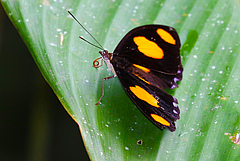11.03.2019 | TOP NEWS, Biodiversity Conservation, sDiv, Biodiversity Synthesis, Macroecology and Society, Media Release
A new framework for global species monitoring

Data to assess distributions and trends varies vastly among groups of organisms. Many tropical butterflies like the blue-frosted banner (Catonephele numilia) often only have a few records (picture: Walter Jetz).

Bird species in North America or Europe like the mallard (Anas platyrhynchos) on the other hand are mostly well documented with millions of records annually (picture: Walter Jetz).
Note for the media: Use of the pictures provided by iDiv is permitted for reports related to this media release only, and under the condition that credit is given to the picture originator.
Based on a media release by Yale University, USA:
New Haven, Leipzig. A group of international experts including scientists of the German Centre for Integrative Biodiversity Research (iDiv) has developed a much-needed framework to significantly improve the monitoring of status and trends of species worldwide. This finding comes after a multi-year collaboration under the auspices of the Group on Earth Observations Biodiversity Observation Network (GEO BON). Their report is now published in Nature Ecology & Evolution.
Changes to biodiversity are already happening with severe potential consequences to all species, including humans, the researchers say. The loss or invasion of a single species can dramatically alter the function of an entire ecosystem, explained Walter Jetz, lead author and Yale professor of ecology and evolutionary biology and of forestry and environmental studies. Jetz conducted parts of the study Parts during a sabbatical at the iDiv research center in cooperation with the iDiv researchers Henrique Pereira (iDiv, Martin Luther University Halle-Wittenberg - MLU), Petr Keil (iDiv, MLU) and Carsten Meyer (iDiv, Leipzig University).
Yet, current information about how and where species populations are changing on the planet remains “woefully inadequate,” according to study co-author Melodie McGeoch of Monash University, Australia. It lags far behind scientists’ monitoring of other aspects of environmental change, she explained.
Following in the footsteps of a similar approach in climate science to characterize core information, the researchers first identified “essential variables” for addressing species populations. These are standardized measures that with the aid of other information — such as that gathered by satellite-based remote sensing — and models integrate the often gap-ridden raw species data to give a clear picture of the distribution and abundance of species. The experts then laid out recommended practices that support this framework, such as better data sharing across national borders and enhanced collaboration between the varied parties involved in relevant data collection, from amateurs to government agencies.
“We hope that the presented concept and framework for global species monitoring will lay an important foundation for the collection and use of biodiversity data in support of conservation and resource management worldwide. Any agencies, businesses, conservation organizations, or international bodies concerned with the management of our lands and oceans would benefit from more reliable and representative information about the status and trends of species,” said Jetz.
The study’s suggestions also have the potential to help researchers themselves, he said. Improved global species monitoring would help close knowledge gaps that hinder present research that requires spatial biodiversity information, especially information about parts of the world and the tree of life that are hard to document through current practices.
The study was developed with support from GEO BON and the German Centre for Integrative Biodiversity Research, iDiv. Additional funding was provided by grants from the National Science Foundation and the National Aeronautics and Space Administration.
Original publication:(iDiv researchers in bold)
Walter Jetz, Melodie A. McGeoch, Robert Guralnick, Simon Ferrier, Jan Beck, Mark J. Costello, Miguel Fernandez, Gary N. Geller, Petr Keil, Cory Merow, Carsten Meyer, Frank E. Muller-Karger, Henrique M. Pereira, Eugenie C. Regan, Dirk S. Schmeller, Eren Turak (2019) Essential biodiversity variables for mapping and monitoring species populations. Nature Ecology and Evolution, DOI 10.1038/s41559-019-0826-1. Further information:
Group on Earth Observations Biodiversity Observation Network (GEO BON): https://geobon.org/Contact:Prof Walter Jetz (speaks English and German)
Ecology and Evolutionary Biology, Yale University, New Haven, CT, USA
Phone: +1 203 432 7540
Email: walter.jetz@yale.edu
Web: https://jetzlab.yale.edu/people/walter-jetzDr Tabea Turrini
Media and Communications
German Centre for Integrative Biodiversity Research (iDiv) Halle-Jena-Leipzig
Tel: +49 341 9733-106
Email: tabea.turrini@idiv.de
